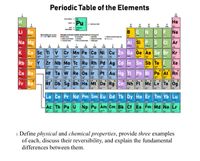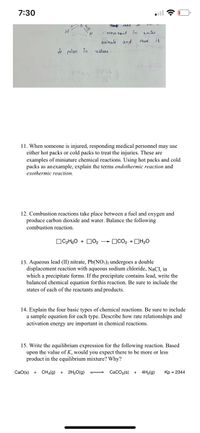
Chemistry
10th Edition
ISBN: 9781305957404
Author: Steven S. Zumdahl, Susan A. Zumdahl, Donald J. DeCoste
Publisher: Cengage Learning
expand_more
expand_more
format_list_bulleted
Question
What’s the answer to question 14

Transcribed Image Text:Periodic Table of the Elements
VIA
kenicnter 94
-
Pu
Не
13
14
NA
15
16
17
VIA
IIA
IIA
VA
VIA
Name Pke
Aamic D
Li Be
C
N
Ne
a tter lr
AS LD S
Setcategaryinthe meal-mtal talen oler afedgord
lad
Bey
Alkai netaa
Alirerhra Actinides
Metalaid
actieta adte
antwiol praperties
14
Tstan res
Petranstenrt ktia gass
Na Mg
Al Si P
S
CI Ar
12
10
VIID
11
VID
VII
VII
VID
IB
34
29
2
K
K
Ca Sc Ti V
Cr Mn Fe Co Ni Cu Zn Ga Ge As Se Br Kr
Tan
H
37
42
44
45
$2
Rb Sr Y
Zr Nb Mo Tc Ru Rh Pd Ag Cd In Sn Sb Te
Xe:
12
77
Cs Ba
Hf Ta W Re Os Ir
PtAu Hg TI Pb Bi Po At Rn
17
104
108
110
T6
Fr Ra
Rf Db: Sg Bh Hs Mt Ds Rg Cn Nh Fl Mc Lv Ts Og
Ce Pr Nd Pm Sm Eu Gd Tb Dy Ho Er Tm Yb Lu
Mertion
Ac Th Pa u Np Pu Am bm Bk CI És im Md No Lr
100
Np Pu Am Cm Bk Cf Es Fm Md No Lr
Therism
are
1. Define physical and chemical properties, provide three examples
of each, discuss their reversibility, and explain the fundamental
differences between them.

Transcribed Image Text:7:30
TAME
meve mant in
wateu
moleenle and
thus
it
i polan in
natuu :
11. When someone is injured, responding medical personnel may use
either hot packs or cold packs to treat the injuries. These are
examples of miniature chemical reactions. Using hot packs and cold
packs as anexample, explain the terms endothermic reaction and
exothermic reaction.
12. Combustion reactions take place between a fuel and oxygen and
produce carbon dioxide and water. Balance the following
combustion reaction.
OC2H,O + D02
OCO2 +DH20
13. Aqueous lead (II) nitrate, Pb(NO;)2 undergoes a double
displacement reaction with aqueous sodium chloride, NaCl, in
which a precipitate forms. If the precipitate contains lead, write the
balanced chemical equation forthis reaction. Be sure to include the
states of each of the reactants and products.
14. Explain the four basic types of chemical reactions. Be sure to include
a sample equation for each type. Describe how rate relationships and
activation energy are important in chemical reactions.
15. Write the equilibrium expression for the following reaction. Based
upon the value of K, would you expect there to be more or less
product in the equilibrium mixture? Why?
CaO(s) +
CHa(g) +
2H20(g)
CacOa(s) +
4H2(g)
Kp = 2344
Expert Solution
This question has been solved!
Explore an expertly crafted, step-by-step solution for a thorough understanding of key concepts.
This is a popular solution
Trending nowThis is a popular solution!
Step by stepSolved in 4 steps with 1 images

Knowledge Booster
Similar questions
- Viruses have unique characteristics that make them useful in biotechnological applications. Discuss why viruses make good tools in the laboratory for curing, preventing or understanding disease.arrow_forwardWhat types of carbohydrates can the iodine test distinguish and what is the color change expected?arrow_forwardComplete this reaction: He + He +He + iparrow_forward
- 7. QUALITATIVE ANALYSIS OF CARBOHYDRATES PRELAB QUESTIONS NAME 1. Identify the purpose of each test in the space provided. a) Benedict's test b) Seliwanoff's test c) Iodine test 2. A student ran an analysis on an unknown carbohydrate and observed the following results. The Benedict's test turned cloudy and the color changed from blue to brick red. The Sweliwanoff's test produced a light pink color after heating. The solution in the iodine test did not change color. a) Does the sugar contain an aldehyde or ketone? If so, which one? b) Is the unknown or simple or complex carbohydrate? 601arrow_forwardC) NUCLEIC ACID Sketch the general structure of a nucleic acid monomer and name all characteristic chemical groups: TETAAL Sketch the general structure of a nucleic acid polymer and name all characteristic chemical group: Name of bond between monomers: D) LIPID Sketch the general structure of a triglyceride molecule, name the characteristic chemical groups that form the molecule, and label the chemical linkages between the groups: inte imveneg Sketch the general structure of a phospholipid molecule, name the characteristic chemical groups that form the mol- ecule, and show how phospholipids align to create cell membranes. Name the characteristic that distinguishes all lipids from other large molecules:arrow_forwardMarks: 1 Stereochemistry is the study of: Choose one answer. a. organic chemistry b. two-dimensional chemistry c. theoretical chemistry d. three-dimensional chemistryarrow_forward
- What effect do restriction enzymes have on DNA? Select one: Restriction enzymes repair damaged portions of DNA. O Restriction enzymes cleave DNA at specific sequences into fragments. Restriction enzymes give a negative charge to DNA. Restriction enzymes duplicate DNA.arrow_forwardWhy is melphalan a good cancer drug?arrow_forwardC3H60 + H30+ are the reactants what are the products?arrow_forward
- What is an antioxidant enzyme? Why is catalase considered to be an antioxidant enzyme?arrow_forward13. Some fungi live as single-celled organisms. Group of answer choices True False 14. For a fungus, a fruiting body such as a mushroom serves which function? Group of answer choices Allowing asexual reproduction by fragmentation Spreading spores produced during sexual reproduction Causing disease by consuming tissues in an animal host Storing nutrients as a permanent organ in the fungus Question 15 What sort of diseases can be treated with antibiotics? Group of answer choices Cancers Diseases caused by viruses Diseases caused by fungi Diseases caused by bacteria Question 16 Which of the following is an example of a bacterium causing harm to another organism? Group of answer choices Tuberculosis in humans caused by Mycobacterium tuberculosis Protozoa in the genus Plasmodium causing malaria in humans Fungi in the genus Penicillium producing penicillin that kills nearby bacteria The ghost plant Monotropa uniflora stealing nutrients from fungi NOV 14 MacBe esc 80 O00 000 F1 F2arrow_forwardPlease answer the following question:arrow_forward
arrow_back_ios
SEE MORE QUESTIONS
arrow_forward_ios
Recommended textbooks for you
 ChemistryChemistryISBN:9781305957404Author:Steven S. Zumdahl, Susan A. Zumdahl, Donald J. DeCostePublisher:Cengage Learning
ChemistryChemistryISBN:9781305957404Author:Steven S. Zumdahl, Susan A. Zumdahl, Donald J. DeCostePublisher:Cengage Learning ChemistryChemistryISBN:9781259911156Author:Raymond Chang Dr., Jason Overby ProfessorPublisher:McGraw-Hill Education
ChemistryChemistryISBN:9781259911156Author:Raymond Chang Dr., Jason Overby ProfessorPublisher:McGraw-Hill Education Principles of Instrumental AnalysisChemistryISBN:9781305577213Author:Douglas A. Skoog, F. James Holler, Stanley R. CrouchPublisher:Cengage Learning
Principles of Instrumental AnalysisChemistryISBN:9781305577213Author:Douglas A. Skoog, F. James Holler, Stanley R. CrouchPublisher:Cengage Learning Organic ChemistryChemistryISBN:9780078021558Author:Janice Gorzynski Smith Dr.Publisher:McGraw-Hill Education
Organic ChemistryChemistryISBN:9780078021558Author:Janice Gorzynski Smith Dr.Publisher:McGraw-Hill Education Chemistry: Principles and ReactionsChemistryISBN:9781305079373Author:William L. Masterton, Cecile N. HurleyPublisher:Cengage Learning
Chemistry: Principles and ReactionsChemistryISBN:9781305079373Author:William L. Masterton, Cecile N. HurleyPublisher:Cengage Learning Elementary Principles of Chemical Processes, Bind...ChemistryISBN:9781118431221Author:Richard M. Felder, Ronald W. Rousseau, Lisa G. BullardPublisher:WILEY
Elementary Principles of Chemical Processes, Bind...ChemistryISBN:9781118431221Author:Richard M. Felder, Ronald W. Rousseau, Lisa G. BullardPublisher:WILEY

Chemistry
Chemistry
ISBN:9781305957404
Author:Steven S. Zumdahl, Susan A. Zumdahl, Donald J. DeCoste
Publisher:Cengage Learning

Chemistry
Chemistry
ISBN:9781259911156
Author:Raymond Chang Dr., Jason Overby Professor
Publisher:McGraw-Hill Education

Principles of Instrumental Analysis
Chemistry
ISBN:9781305577213
Author:Douglas A. Skoog, F. James Holler, Stanley R. Crouch
Publisher:Cengage Learning

Organic Chemistry
Chemistry
ISBN:9780078021558
Author:Janice Gorzynski Smith Dr.
Publisher:McGraw-Hill Education

Chemistry: Principles and Reactions
Chemistry
ISBN:9781305079373
Author:William L. Masterton, Cecile N. Hurley
Publisher:Cengage Learning

Elementary Principles of Chemical Processes, Bind...
Chemistry
ISBN:9781118431221
Author:Richard M. Felder, Ronald W. Rousseau, Lisa G. Bullard
Publisher:WILEY